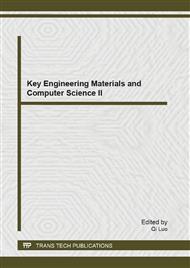[1]
Zissman, M.A., Comparison of four approaches to automatic language identification of telephone speech, IEEE Trans. Speech & Audio Proc., Vol. 4, No. 1, pp.31-44, 1996.
DOI: 10.1109/tsa.1996.481450
Google Scholar
[2]
Navratil, J. 2001. Spoken Language Recognition – A Step toward Multi-linguality in Speech Processing, IEEE Trans. Speech&Audio Proc., Vol. 9, No. 6, pp.678-685, 2001.
DOI: 10.1109/89.943345
Google Scholar
[3]
Torres-Carrasquillo, P.A., Reynolds, D.A., Deller Jr., J.R., Language identification using Gaussian mixture model tokenization, IEEE ICASSP 2002, pp. I-757-760.
DOI: 10.1109/icassp.2002.1005850
Google Scholar
[4]
Chong Feng, He-yan Huang, Zhao-xiong Chen, Liang Zhang, Multiple Language Identification Based on Character-level Markov Models, Computer Science, Vol. 33, No. 1, pp.226-228, 2006.
Google Scholar
[5]
Chen-Lin Huang, Chung-Hsien Wu, Generation of phonetic units for mixed-language speech recognition based on acoustic and contextual analysis, IEEE Transactions on Computers, Vol. 56, No. 9, pp.1225-1233, 2007.
DOI: 10.1109/tc.2007.1064
Google Scholar
[6]
GARCIA E. G., MENGUSOGLU E., ERIC JANKE, Multilingual acoustic models for speech recognition in low resource devices, Acoustics, Speech and Signal Processing, pp.981-984, 2007.
DOI: 10.1109/icassp.2007.367236
Google Scholar
[7]
Hui Sun, Fang Zheng, Wen hu-Wu, Confidence scoring using context dependent features for word verification, Journal of Tsinghua University (Science and Technology), Vol. 46, No. 1, pp.94-97, 2006.
Google Scholar
[8]
Tie Ran-Zheng, Zhan Zhang, Ji Qing-Han, Keyword Spotting Based on Restricting Model and Acoustic Confidence Measure, Computer Science, Vol. 35, No. 11, pp.216-218, 2008.
Google Scholar
[9]
Bin Feng-Yan, Xiao Yan-Zhu, Zhi Jiang-Zhang, Confidence Measures and Integrating Algorithm in Utterance Verification, Vol. 17, No. 12, pp.2547-2553, 2006.
DOI: 10.1360/jos172547
Google Scholar
[10]
Bin Dong, Qing Wei-zhao, Yong Hong-Yan, Confidence measure for telephone speech recognition, Technical Acoustics, Vol. 25, No. 5, pp.473-477, 2006.
Google Scholar
[11]
METZE E., KEMP T., SCHAAJ T., Confidence measure based language identification , Acoustics, Speech, and Signal Processing, pp.1827-1830, 2000.
DOI: 10.1109/icassp.2000.862110
Google Scholar
[12]
KIM T. Y., KO H., Bayesian fusion of confidence measures for speech recognition, IEEE Signal Processing Letters, Vol. 12, No. 12, pp.871-874, 2005.
DOI: 10.1109/lsp.2005.859494
Google Scholar
[13]
Chang-Hoon, LEE Soo-Young, Noise-Robust speech recognition using top-down selective attention with an HMM classifier, IEEE Signal Processing Letters, Vol. 14, No. 7, pp.489-491, 2007.
DOI: 10.1109/lsp.2006.891326
Google Scholar
[14]
Fernández, F., R. de Córdoba, J. Ferreiros, V. Sama, L. F. D'Haro, J. Macías-Guarasa, Language Identification Techniques based on Full Recognition in an Air Traffic Control Task, pp.1565-1568, 2004.
DOI: 10.21437/interspeech.2004-37
Google Scholar


